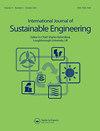利用再生织物边角料开发功能性吸声无纺布
IF 3.6
Q3 GREEN & SUSTAINABLE SCIENCE & TECHNOLOGY
International Journal of Sustainable Engineering
Pub Date : 2022-06-24
DOI:10.1080/19397038.2022.2092230
引用次数: 1
摘要
垃圾回收利用的原因包括节约资源、减少填埋需求、支付相关的倾倒费以及为产品提供低成本的原材料。高速织布机会产生大量的边沿废料。本研究利用机织物边角料的回收利用,研制了缝粘无纺布样品。从织造部门收集边沿废料,用开布器将其转化为纤维。这些纤维是用机械梳理机梳理的。制作无纺布样品,根据ASTM E 1050标准用阻抗管测量吸声系数。试验结果表明,在0 Hz、500 Hz、1000 Hz、1500 Hz、2000 Hz、2500 Hz和3000 Hz的频率水平上,吸声系数随频率水平的增加而增大。随着频率的增加,所有缝接样品的吸声性能都有所提高。同样,吸声性能也随着厚度的增加而增加。密度越大,单位面积的纤维数量越多。密度小、孔隙开放的结构吸收500赫兹的低频声音。纤维密度高的结构对2000赫兹以上的频率有更好的吸收性。显影样品的透气性降低了吸声性能。本文章由计算机程序翻译,如有差异,请以英文原文为准。
Development of non-woven from recycled fabric selvedge wastes for functional sound absorption
ABSTRACT Reasons for recycling of waste include conservation of resources, reduction in the need for landfills, paying associated tipping fees and provision of low-cost raw materials for products. A high-speed weaving machine generates a high amount of selvedge wastes. In this study, stitch-bonded non-woven samples were developed by recycling woven fabric selvedge wastes. Selvedge wastes were collected from the weaving department and changed to fibre by using a fabric opener. The fibres are carded by a mechanical carding machine. Non-woven samples were developed, and sound absorption coefficients were measured by an impedance tube according to the ASTM E 1050 standard. The test result shows that the sound absorption coefficient increased with an increasing frequency level of 0 Hz, 500 Hz, 1000 Hz, 1500 Hz, 2000 Hz, 2500 Hz and 3000 Hz. The sound absorption property of all stitch-bonded samples was increased with increasing frequency. Similarly, the sound-absorbing property also increases with the increase in the thickness. The larger the density, the higher the number of fibres per unit area. Structures with less density and open pores absorb the sound with a low frequency of 500 Hz. Structures with high fibre density have better absorbency for frequency levels above 2000 Hz. The air permeability property of the developed sample decreases the sound-absorbing performance.
求助全文
通过发布文献求助,成功后即可免费获取论文全文。
去求助
来源期刊

International Journal of Sustainable Engineering
GREEN & SUSTAINABLE SCIENCE & TECHNOLOGY-
CiteScore
7.70
自引率
0.00%
发文量
19
 求助内容:
求助内容: 应助结果提醒方式:
应助结果提醒方式:


